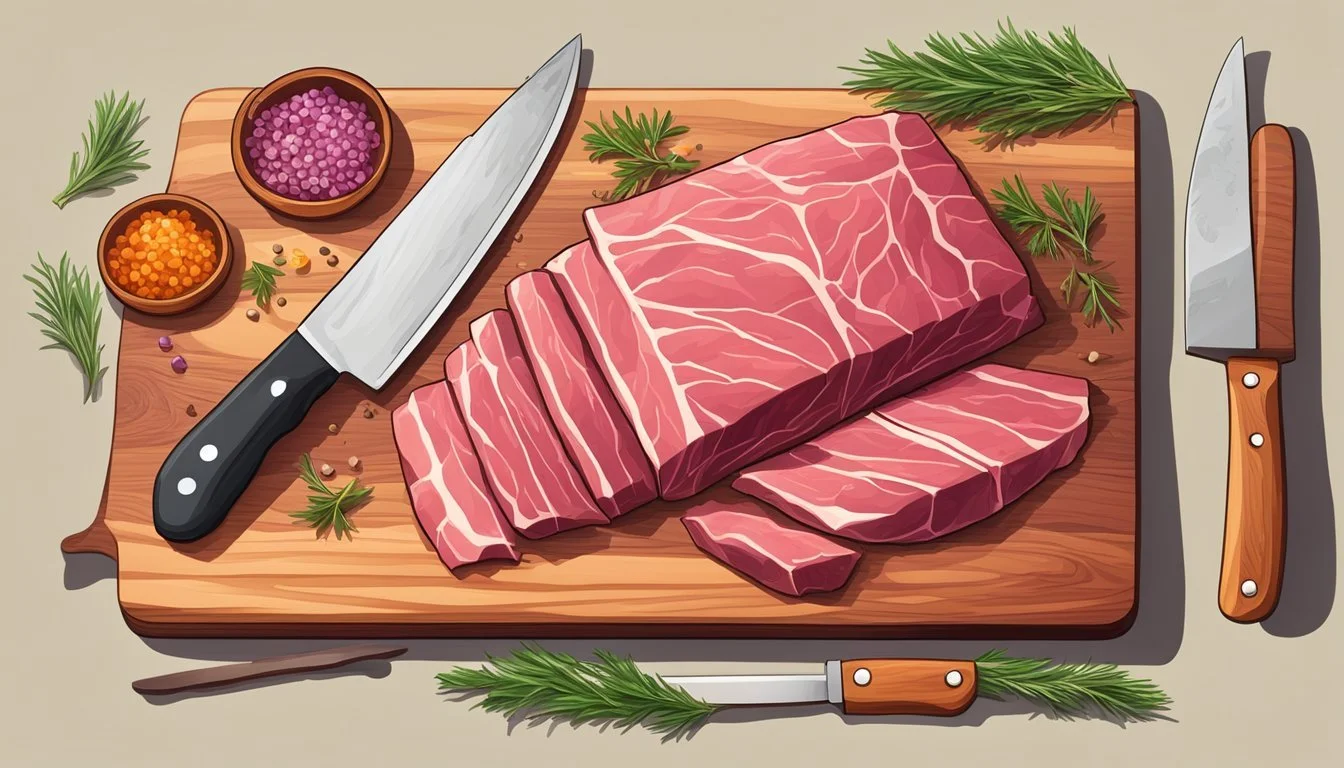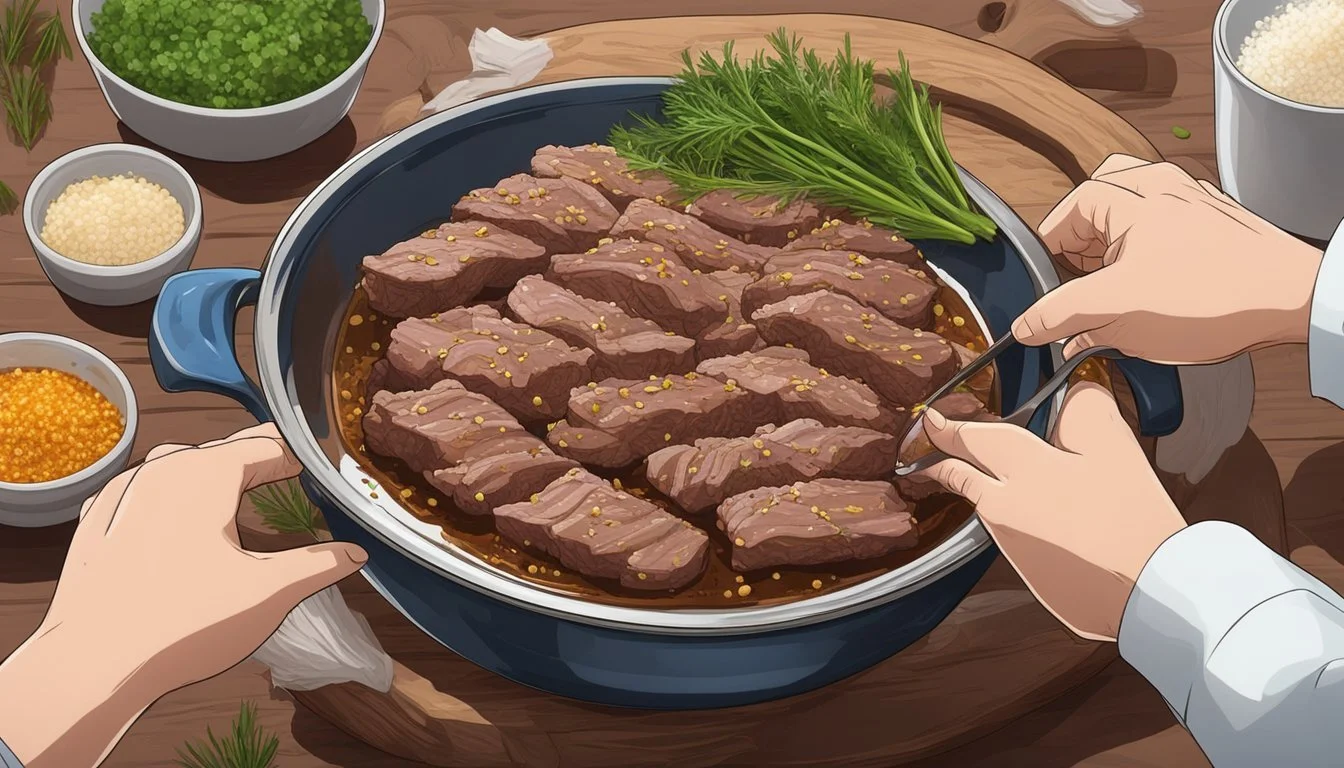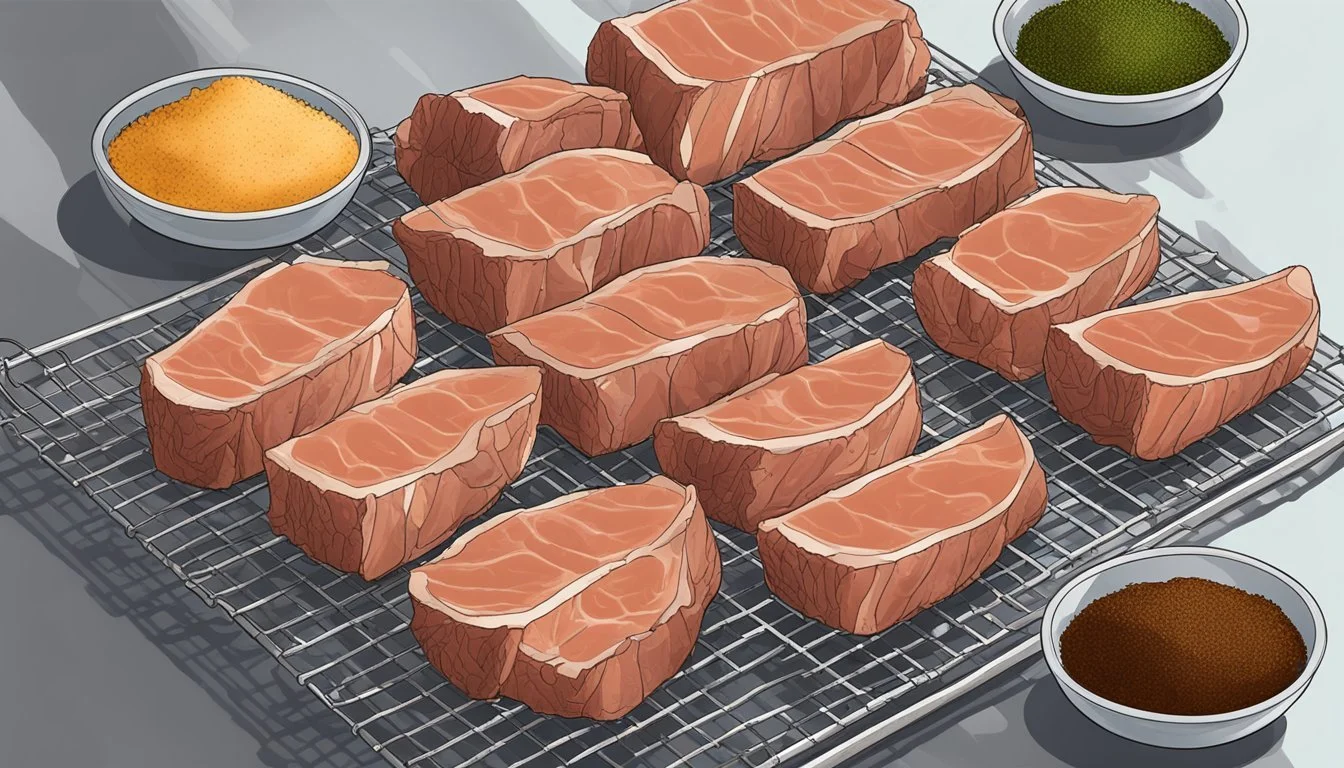Lamb Jerky 101
Crafting Delicious Homemade Treats
Lamb jerky is a delectable and nutritious snack that can easily be made at home with a bit of preparation and patience. Unlike its beef counterpart, lamb jerky brings a distinct, rich flavor profile that stands out for its natural sweetness and robust taste. For beginners looking to craft their own jerky, understanding the basics of meat preparation, seasoning, and drying methods is essential. Homemade jerky offers the advantage of tailoring flavors to personal preferences and the assurance of preservative-free snacking.
The process begins with selecting the right cut of lamb, which should be lean to reduce drying time and to ensure the finished jerky is not too tough. Freezing the meat briefly before slicing aids in cutting consistent, thin strips that are key for even drying. After slicing, the meat is typically marinated or seasoned with a mixture of spices, herbs, and sometimes a touch of sweetness to enhance the lamb's natural flavors. The seasoned lamb is then cured, which can vary from a simple rub to a more involved process involving refrigeration.
Successful dehydration can be achieved through various methods, such as using a dehydrator, oven-baking, or even air-drying in the right conditions. Timing is crucial to achieve the perfect chewiness without over-drying. With homemade lamb jerky, hobbyists not only get to enjoy crafting their snack from scratch but also reap the benefits of a high-protein, low-fat treat that’s customized to their flavor preferences.
Exploring the Basics of Jerky
When one delves into making jerky, it is essential to understand its definition, appreciate the benefits of homemade versions, and select the appropriate meat for production—a process offering a high-protein snack from various lean meats.
What is Jerky?
Jerky is a nutrient-dense, dehydrated meat that has been trimmed of fat, sliced, and dried to prevent spoilage. The dehydration process significantly reduces its moisture content, making it a protein-packed and portable food. It can be made from different types of lean meat, including beef, lamb, and poultry, and is seasoned with various spices and marinades before drying.
Benefits of Homemade Jerky
Making jerky at home allows one to take advantage of several key benefits:
Control over Ingredients: Homemade jerky means complete control over the cuts of meat and the seasonings used, allowing for a healthier product devoid of preservatives and additives.
Flavor Customization: One can experiment with marinades and spice blends to create a unique flavor that caters to personal preferences.
Cost Efficiency: Purchasing and processing in bulk can be more economical and produce a greater quantity of jerky compared to store-bought options.
Understanding Meat Selection
The choice of meat is crucial in jerky preparation. For an optimal outcome, one should consider the following:
Select Lean Meats: Fatty meats can spoil faster. Ideal choices include top round, flank steak, and sirloin tip.
Consistent Thickness: When slicing meat for jerky, uniform thickness ensures even dehydration and texture.
Grain Consideration: Slicing meat across the grain results in jerky that's easier to chew, while slicing with the grain offers a tougher texture.
Identifying and using the appropriate meat not only enhances flavor but also ensures a high-quality, protein-rich snack.
Preparation Essentials
When making lamb jerky at home, it's crucial to select the proper cut, trim and slice the meat accurately, and use a well-crafted marinade to ensure both flavor and preservation.
Choosing the Right Cut of Meat
The cut of meat is paramount for successful jerky. Look for lean cuts of lamb, like the leg or loin, that have little to fat. Excess fat can cause the jerky to spoil faster. The slice of the meat should be consistent to ensure even drying.
Trimming and Slicing Techniques
Trimming away all visible fat is a critical step before slicing the meat. After trimming, partially freeze the lamb to facilitate slicing into uniform thin strips, about 1/4 inch thick. It’s essential to slice against the grain, which helps in creating a tender jerky.
Importance of Marinade
The marinade acts both as a seasoning and a preservative for the jerky. A blend of salt, soy sauce, worcestershire sauce, garlic, and black pepper is often used. Ensure every slice is thoroughly coated. Typically, the lamb should marinate in the refrigerator from 4 to 12 hours to allow the flavors to penetrate and the salt to start the curing process.
Marinating and Seasoning
Marinating and seasoning are critical steps in making lamb jerky, transforming the meat with a rich combination of flavors and setting the stage for dehydration.
Creating Your Marinade Mix
To create a marinade for lamb jerky, one would mix liquid ingredients such as soy sauce and Worcestershire sauce to add umami depth, while liquid smoke imparts a smoky flavor. For a single pound of lamb, combining approximately 1/2 cup of soy sauce and 1/4 cup of Worcestershire sauce creates a solid base to which other ingredients are added.
Balancing Flavors
One must balance salty, sweet, and spicy components to achieve a well-rounded marinade. Honey can provide a touch of sweetness while chili powder adds heat. Garlic powder, onion powder, and ginger offer aromatic qualities. Here is an example balance for the marinade:
Saltiness: 1/2 cup soy sauce
Sweetness: 2 tablespoons honey
Heat: 1 teaspoon chili powder
Aroma: 1 teaspoon garlic powder, 1 teaspoon onion powder, 1/2 teaspoon ground ginger
One should season the marinade with black pepper and salt, adjusting these to taste.
Duration and Tips for Marinating
The lamb should marinate for at least 6 hours, though overnight is preferable for more intense flavor. Lamb slices or strips are submerged in the marinade ensuring each piece is thoroughly coated. For best results, the marinating should take place in a sealed container or a zip-locked bag kept in the refrigerator. Periodically turning the bag will ensure even marination.
Note: It's crucial to squeeze out excess air from the bag before sealing to enhance marination efficiency.
Drying and Dehydrating Methods
Proper drying and dehydrating are crucial for creating safe, flavorful lamb jerky. This section discusses various methods to achieve optimal dryness using different equipment.
Using a Dehydrator
A dehydrator is specifically designed to remove moisture from food, including meat, at a consistent temperature. For lamb jerky, the user should:
Arrange the meat evenly on the dehydrator racks.
Set the temperature between 135°F and 160°F.
Regularly check the meat until it is adequately dry and leathery.
Oven Drying
Ovens can be a practical alternative to dehydrators for making jerky. The user should:
Preheat the oven to 165°F.
Place meat strips on a rack above a baking sheet to allow airflow.
Leave the oven door slightly open to let moisture escape and dry jerky evenly.
Alternative Drying Methods
While dehydrators and ovens are the most common, alternative methods exist. A well-ventilated area or a smoker can also be used to dry jerky. These methods require careful attention to:
Temperature: It must be high enough to dry the meat but not cook it.
Airflow: Adequate airflow is essential to dehydrate the jerky properly.
Time: Drying times can vary, so regular checks are necessary to avoid over-drying.
Safety and Storage
When making homemade lamb jerky, one must ensure the jerky is safe to eat and is stored correctly to prolong its shelf life effectively.
Ensuring Jerky is Safe to Eat
To produce safe-to-consume jerky, it's crucial to begin with high-quality meat and adhere to proper food safety protocols. The meat should be trimmed of fat and sliced thinly to ensure even drying. Temperature control is paramount: the jerky must be dried at a minimal internal temperature of 145 to 155°F for 6 hours, a critical measure to eliminate pathogens. Post-drying, it is recommended to heat the jerky in a preheated 275°F oven for 10 minutes to further ensure safety.
Storing Homemade Jerky
Once the jerky has cooled, the focus shifts to storage, which can significantly impact its shelf-stability and taste.
Immediate Storage: Store jerky in airtight containers or vacuum-sealed bags to minimize exposure to air and moisture.
Refrigeration: For a storage time up to a month, one can refrigerate their jerky to maintain quality and taste.
Freezing: If storage beyond a month is needed, freezing the jerky is an option although it may alter its flavor. Place the jerky in the freezer, and it can remain safe for consumption for up to 6 months.
By following these guidelines, one can enjoy homemade lamb jerky that is both safe and delicious for an extended period.
Types of Jerky
Jerky is a diverse and flavorful world, offering options from classic beef variants to exotic game and even seafood-based jerky. While exploring, one discovers the vast array of tastes and textures that dried meat has to offer.
Beef Jerky Varieties
Beef jerky is the most traditional and popular jerky. It comes in numerous flavors and cuts, partially dictated by the beef's preparation and seasoning. The marbling and tenderness of the meat cuts—usually top round or brisket—play a critical role in the final product's chewiness and flavor. One might find everything from classic Original and Teriyaki to inventive takes like Chili Lime or Smoky Bourbon.
Exploring Game and Turkey Jerky
Moving beyond beef, jerky enthusiasts often branch out to game meats like bison, elk, or venison. These meats provide a leaner, often richer option with a distinctive taste profile. Turkey jerky is another preferred alternative, sought after for its lower fat content compared to pork and beef, and for being a flavorful light snack that's high in protein.
Fish Jerky and Other Proteins
The realm of jerky is not landlocked—fish jerky made from salmon or tuna is gaining popularity. It's praised for its omega-3 fatty acids and a softer texture than its terrestrial counterparts. Smoked and seasoned, it captures the essence of the sea. Additionally, for those on the lookout for something different, there is jerky made from pork, with a sweeter, richer profile.
Advanced Jerky Making Techniques
As the art of jerky making advances, enthusiasts explore intricate flavors and invest in specialized equipment. Developing complex taste profiles and understanding the mechanics behind jerky processing can significantly enhance the final product.
Experimenting with Flavors and Cuts
Flavor Profiles:
Boldness: Incorporate paprika and red pepper flakes for a smoky, spicy kick.
Herbal Notes: Fine-tune the herb mix to compliment the lamb's robust profile.
Meat Cuts:
Eye of round: A lean, economical cut ideal for jerky due to its consistent texture.
Sirloin: Offers a balance between tenderness and flavorful marbling.
Technique Tips:
Marination: Longevity is key. Let your marinade permeate the meat for at least 12 hours.
Thickness: Use a rolling pin or meat tenderizer to ensure uniform thickness before drying.
Tools and Equipment for Jerky Making
Equipment List:
Equipment Purpose Smoker Infuses smoky flavor and facilitates even drying. Dehydrator Provides controlled drying environment for consistent results. Grinder Creates ground jerky blends, allowing for different textural experiences. Wire Rack Essential for air circulation when oven-drying jerky.
Best Practices:
Spraying: Apply cooking spray to the wire rack to prevent sticking.
Monitoring: Keep a vigilant eye on your drying meat, checking for the desired doneness without over-drying.
By harnessing these advanced techniques, one can craft high-quality lamb jerky with complex flavors and perfect textures.
Tips and Tricks for Perfect Jerky
In crafting the perfect lamb jerky, specific techniques in slicing, monitoring during the drying process, and final packaging are crucial for optimal texture, flavor, and shelf-life.
Slicing and Thickness Tips
The thickness of the lamb slices is pivotal for the consistency of the jerky. The ideal thickness is 1/4 to 1/2 inch. Slices that are too thick will not dry evenly and may result in a product that's hard to chew, while slices too thin can become overly dry and crumbly. It's recommended to:
Freeze the lamb slightly before slicing to achieve uniform thickness.
Use a sharp knife or a meat slicer for consistent slices.
Slice against the grain for a texture that's easier to chew.
Monitoring Dryness
Ensuring the jerky reaches the ideal level of dryness is key for both taste and preservation without the need for additional calories from preservatives. Lamb jerky should be pliable but not moist. To monitor dryness:
Check the jerky every hour after the first few hours of drying.
Jerky is done when it bends and cracks but does not break.
Packaging and Presentation
Proper packaging is essential to maintain the quality of the jerky. For best results:
Allow the jerky to cool completely before packaging to prevent condensation.
Store in a Ziploc bag or vacuum-sealed container to keep out moisture and air.
For an extended shelf-life, include a desiccant packet to absorb any residual moisture.
By meticulously following these tips and tricks, you can ensure that your homemade lamb jerky is not only delicious but also has the perfect chewy texture and a long-lasting freshness.
Jerky Recipes and Ideas
Creating homemade lamb jerky involves two primary avenues: sticking to time-tested classics or experimenting with new, exciting flavor blends. The following recipes and ideas offer a solid foundation for beginners and inspiration for seasoned jerky enthusiasts.
Classic Jerky Recipes
Slice lamb meat into consistent 1/4" thick strips, going with the grain.
Marinate the sliced lamb in a mixture of soy sauce, Worcestershire sauce, garlic powder, and black pepper for at least 4 hours, preferably overnight in a refrigerator.
Dry the marinated lamb strips in a dehydrator or oven until the jerky is firm and chewy, typically for about 4–6 hours at 160°F (71°C).
Prepare a dry rub with coarse salt, cracked black pepper, and smoked paprika.
Coat the lamb slices in the seasoning mix and cure in the refrigerator for around 24 hours.
Dehydrate the seasoned lamb in a single layer until it reaches the desired level of dryness.
Innovative Flavor Combinations
Herb and Citrus Zest Jerky
Marinate lamb strips in a fusion of fresh rosemary, thyme, lemon zest, and olive oil for a refreshing twist.
Method: Marinate overnight, then dehydrate at 165°F (74°C) until completely dry.
Spicy Sweet Jerky
Combine chili powder, brown sugar, cayenne pepper, and apple cider vinegar for a bold kick with a sweet finish.
Instructions: Soak the lamb strips for at least 8 hours, then lay them out to dry until they are adequately dehydrated.
With these recipes as a starting point, one can easily master the craft of making lamb jerky at home, whether they prefer the classic savory taste or are inclined to try out new flavor profiles.







